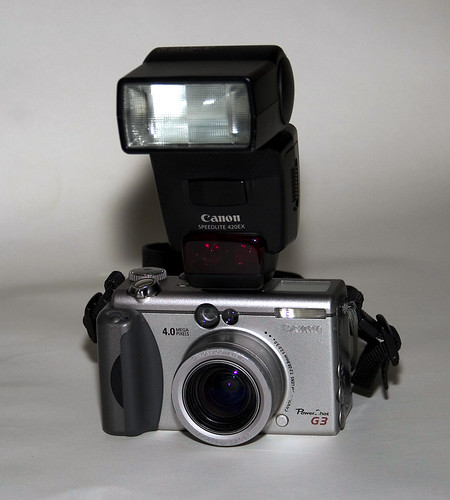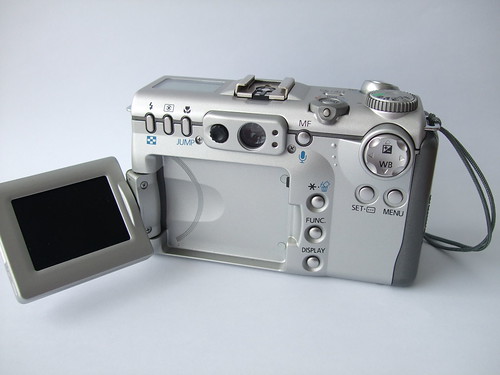Difference between revisions of "Canon PowerShot G3"
m (fix txt) |
Hanskerensky (talk | contribs) (Added link to user manual page) |
||
| (12 intermediate revisions by 5 users not shown) | |||
| Line 1: | Line 1: | ||
{{Flickr_image | {{Flickr_image | ||
| − | |image_source= http://www.flickr.com/photos/ | + | |image_source= http://www.flickr.com/photos/fortinbras/2796061552/in/pool-camerawiki |
| − | |image= http://farm4.static.flickr.com/ | + | |image= http://farm4.static.flickr.com/3245/2796061552_25f49cacaa.jpg |
|image_align= right | |image_align= right | ||
| − | |image_text= | + | |image_text= |
| + | |image_by= Dan Iggers | ||
| + | |image_rights= non-commercial | ||
}} | }} | ||
The '''PowerShot G3''' is a 4 [[megapixel]] compact [[digital camera]] with a 4x optical zoom lens, made by [[Canon]]. It was introduced in September 2002. | The '''PowerShot G3''' is a 4 [[megapixel]] compact [[digital camera]] with a 4x optical zoom lens, made by [[Canon]]. It was introduced in September 2002. | ||
| − | The Canon PowerShot G3 is | + | The Canon PowerShot G3 is a highly-regarded camera in the Canon G-range, although its 4 megapixel image [[sensor]] may sound dated today. The important features this camera offers, however, are the fast lens with a particularly good close-up range, an optical viewfinder for eyelevel photographing, and a capability to deliver images with natural colors and skin hues. A very useful LCD screen, which can be twisted and turned for viewing from almost any direction, is very convenient, especially for on the ground macro photography, and for above the crowd over the head shooting. The image on the screen is always the right way up, regardless of how the screen is rotated, and the camera includes horizontal/vertical format information in the picture file. |
| − | The provision for live "remote capture" photography, using the USB cable for connection to a personal computer, is particularly valuable for studio work, providing full control using the computer for the camera settings and on-screen image preview. The files can be directly | + | The provision for live "remote capture" photography, using the USB cable for connection to a personal computer, is particularly valuable for studio work, providing full control using the computer for the camera settings and on-screen image preview. The files can be directly downloaded for further processing, and be instantly evaluated using the photographer's image-editing program on the computer. |
The separately available lens adapter, LA-DC58B, that replaces the standard lens barrel collar, provides an extremely useful 58mm filter thread for lens attachments, enabling the use of normal filters, close-up lenses, and the separately available wide-angle and tele-converters, or any other useful attachment like a slide/negative-adapter for digitalizing any size of film format. | The separately available lens adapter, LA-DC58B, that replaces the standard lens barrel collar, provides an extremely useful 58mm filter thread for lens attachments, enabling the use of normal filters, close-up lenses, and the separately available wide-angle and tele-converters, or any other useful attachment like a slide/negative-adapter for digitalizing any size of film format. | ||
The camera is supplied with a useful set of programs on a CD, the required cables, and a small handheld remote control, but perhaps more importantly, a high capacity rechargeable BP-511 battery, and a battery-in-camera mains operated charger, which also powers the camera directly from the mains, making the camera independent of battery power for studio work. The camera takes the CompactFlash type 1 memory card. | The camera is supplied with a useful set of programs on a CD, the required cables, and a small handheld remote control, but perhaps more importantly, a high capacity rechargeable BP-511 battery, and a battery-in-camera mains operated charger, which also powers the camera directly from the mains, making the camera independent of battery power for studio work. The camera takes the CompactFlash type 1 memory card. | ||
| + | {{Flickr_image | ||
| + | |image_source= http://www.flickr.com/photos/dewane/113162837/in/pool-camerawiki | ||
| + | |image= http://farm1.static.flickr.com/38/113162837_a9eaec04ff.jpg | ||
| + | |image_align= right | ||
| + | |image_text= Canon G3 with a 420EX flash | ||
| + | |image_by= dewane | ||
| + | |image_rights= with permission | ||
| + | }} | ||
| − | + | * Lens: 7.2 - 28.8mm f2.0-3.0 (35mm film equivalent: 34 - 140mm) | |
| − | * Lens: 7.2 - 28.8mm f2.0-3.0(35mm film equivalent: 34 - 140mm) | ||
* Sensor: 1/1.8-inch Charge-Coupled Device ([[CCD]]), 4 million effective [[pixel]]s | * Sensor: 1/1.8-inch Charge-Coupled Device ([[CCD]]), 4 million effective [[pixel]]s | ||
* Shutter: 15 - 1/2,000 sec. | * Shutter: 15 - 1/2,000 sec. | ||
| − | * [[Film speed|ISO speed]]: 50-400 equivalent. | + | * [[Film speed|ISO speed]]: 50-400 equivalent |
| + | |||
| + | |||
| + | {{Flickr_image | ||
| + | |image_source= http://www.flickr.com/photos/chi_bellami/6012039405/in/pool-camerawiki | ||
| + | |image= http://farm7.static.flickr.com/6124/6012039405_059df258eb.jpg | ||
| + | |image_align= left | ||
| + | |image_text= Tilt-swivel LCD display | ||
| + | |image_by= Chi Bellami | ||
| + | |image_rights= non-commercial | ||
| + | }} | ||
| + | {{brl}} | ||
== Links == | == Links == | ||
| − | * [ | + | *[https://www.manualslib.com/manual/994513/Canon-Powershot-G3.html Canon PowerShot G3 user manual] at [https://www.manualslib.com/ Manualslib] |
| + | *[http://global.canon/en/c-museum/product/dcc481.html Canon PowerShot G3 page] at [http://global.canon/en/c-museum/index.html The Canon Camera Museum] | ||
| + | *[http://www.dpreview.com/reviews/CanonG3/ PowerShot G3 review] at [http://www.dpreview.com/ dpreview.com] | ||
[[Category: C]] | [[Category: C]] | ||
| − | [[Category: P|Powershot G3]] | + | [[Category:P|Powershot G3 Canon]] |
| − | [[Category: Canon]] | + | [[Category: Canon|Powershot G3]] |
[[Category: Japanese digital]] | [[Category: Japanese digital]] | ||
| + | [[Category:RAW-CRW]] | ||
Latest revision as of 04:51, 11 April 2023

|
| image by Dan Iggers (Image rights) |
The PowerShot G3 is a 4 megapixel compact digital camera with a 4x optical zoom lens, made by Canon. It was introduced in September 2002.
The Canon PowerShot G3 is a highly-regarded camera in the Canon G-range, although its 4 megapixel image sensor may sound dated today. The important features this camera offers, however, are the fast lens with a particularly good close-up range, an optical viewfinder for eyelevel photographing, and a capability to deliver images with natural colors and skin hues. A very useful LCD screen, which can be twisted and turned for viewing from almost any direction, is very convenient, especially for on the ground macro photography, and for above the crowd over the head shooting. The image on the screen is always the right way up, regardless of how the screen is rotated, and the camera includes horizontal/vertical format information in the picture file.
The provision for live "remote capture" photography, using the USB cable for connection to a personal computer, is particularly valuable for studio work, providing full control using the computer for the camera settings and on-screen image preview. The files can be directly downloaded for further processing, and be instantly evaluated using the photographer's image-editing program on the computer.
The separately available lens adapter, LA-DC58B, that replaces the standard lens barrel collar, provides an extremely useful 58mm filter thread for lens attachments, enabling the use of normal filters, close-up lenses, and the separately available wide-angle and tele-converters, or any other useful attachment like a slide/negative-adapter for digitalizing any size of film format.
The camera is supplied with a useful set of programs on a CD, the required cables, and a small handheld remote control, but perhaps more importantly, a high capacity rechargeable BP-511 battery, and a battery-in-camera mains operated charger, which also powers the camera directly from the mains, making the camera independent of battery power for studio work. The camera takes the CompactFlash type 1 memory card.

|
| Canon G3 with a 420EX flash image by dewane (Image rights) |
- Lens: 7.2 - 28.8mm f2.0-3.0 (35mm film equivalent: 34 - 140mm)
- Sensor: 1/1.8-inch Charge-Coupled Device (CCD), 4 million effective pixels
- Shutter: 15 - 1/2,000 sec.
- ISO speed: 50-400 equivalent

|
| Tilt-swivel LCD display image by Chi Bellami (Image rights) |